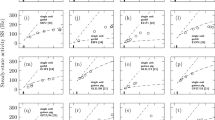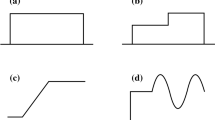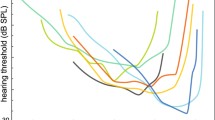Abstract
Cochlear adaptation is postulated to arise in the haircell-first auditory neuron junction due to steady-state reactions between transmitter quanta and receptor sites, thus forming transmitter-receptor complexes which are destroyed enzymatically. The striking resemblance between this mechanism and the occupation and liberation of lines in telephone exchanges led us to apply a well-established stochastic theory for the latter to the adaptation phenomena in the peripheral hearing organ. The theory is evaluated by comparison with experimental data from forward-masking experiments using the compound action potential as a sensor and also with single-nerve fibre data from the literature.
Similar content being viewed by others
References
Auerbach, A.A.: Transmitter release at chemical synapses. In: Structure and function of synapses (Eds.) Pappos, Purpura. Amsterdam: North-Holland Publ. Cie 1972
Cox, D.R., Miller, H.D.: The theory of stochastic processes. London: Methuen & Co. Ltd. 1970
Dallos, P., Schoeny, Z.G., Cheatham, M.A.: Cochlear summating potentials. Acta Oto-Laryngol. Suppl.302, 1–46 (1972)
Davis, H.: A model for transducer action in the cochlea. Cold. Spring Harbor Symp. Quant. Biol.30, 181–190 (1965)
Derksen, H.E.: Axon membrane voltage fluctuations. Acta Physiol. Pharmacol. Neerl.13, 373–466 (1965)
Eggermont, J.J.: The time dependent properties of cochlear action potentials in the guinea pig (in Dutch). Ph. D. Thesis. Leiden 1972
Eggermont, J.J.: Analog modelling of cochlear adaptation. Kybernetik14, 117–126 (1973)
Eggermont, J.J., Spoor, A.: Cochlear adaptation in guinea pigs. A quantitative description. Audiology12, 193–220 (1973a)
Eggermont, J.J., Spoor, A.: Masking of action potentials in the guinea pig cochlea, its relation to adaptation. Audiology12, 221–241 (1973b)
Evans, E.F.: The frequency response and other properties of single fibres in the guinea pig cochlear nerve. J. Physiol. (Lond.)226, 263–287 (1972)
Feller, W.: An introduction to probability theory and its applications. New York: Wiley 1966
Goldstein, M., Kiang, N.: Synchrony of neural activity in electric responses evoked by transient acoustic stimuli. J. Acoust. Soc. Am.30, 107–114 (1958)
Karlin, S.: A first course in stochastic processes. New York: Wiley 1966
Kiang, N.Y.-S., Watanabe, T., Thomas, E.C., Clark, L.F.: Discharge patterns of single nerve fibers in the cats auditory nerve. Res. monograph No. 35. Cambridge: MIT Press 1965
Martin, A.R.: Quantal nature of synaptic transmission. Physiol. Rev.46: 51–66 (1966)
McGill, N.J., Rosenblith, W.A.: Electric responses to two clicks: a simple statistical interpretation. Bull. Math. Biophys.13, 69 (1951)
Murata, K., Taniguchi, I.: Coding scheme in the cochlea. Proc. IUPS,9, 409 (1971)
Sachs, M.B.: Stimulus-response relation for auditory nerve fibers: two-tone stimuli. J. Acoust. Soc. Am.45, 1025–1036 (1969)
Schroeder, M.R., Hall, J.L.: Model for mechanical to neural transduction in the auditory receptor. J. Acoust. Soc. Am.55, 1055–1060 (1974)
Spoendlin, H.: Degeneration behaviour of the cochlear nerve. Arch. Ohr.-, Nas.-, Kehlk.Heilk.280, 275–291 (1971)
Stevens, C.F.: Synaptic physiology. Proc. I.E.E.E.56, 916–930 (1968)
Vere-Jones, D.: Simple stochastic models for the release of quanta of transmitter from a nerve terminal. Austr. J. Statistics8, 53–63 (1966)
Verveen, A.A., Derksen, H.E.: Fluctuation in membrane potential of axons and the problem of coding. Kybernetik2, 152–160 (1965)
Verveen, A.A., Derksen, H.E.: Fluctuation phenomena in nerve membrane. Proc. I.E.E.E.56, 906–916 (1968)
Verveen, A.A., Derksen, H.E.: Amplitude distribution of axon membrane noise voltage. Acta Physiol. Pharmacol. Neerl.15, 353–379 (1969)
Author information
Authors and Affiliations
Rights and permissions
About this article
Cite this article
Eggermont, J.J. Cochlear adaptation: A theoretical description. Biol. Cybernetics 19, 181–189 (1975). https://doi.org/10.1007/BF02281967
Received:
Issue Date:
DOI: https://doi.org/10.1007/BF02281967




